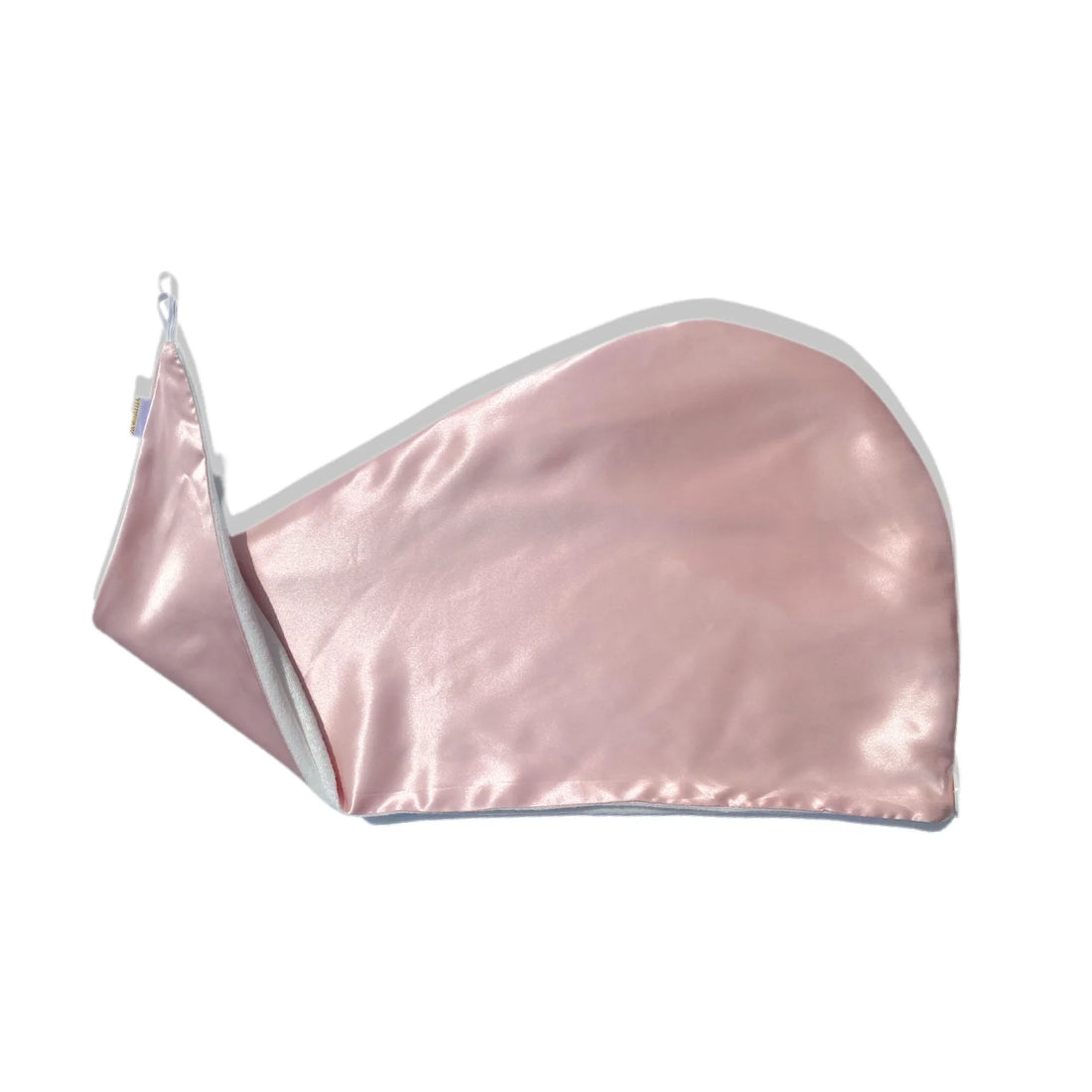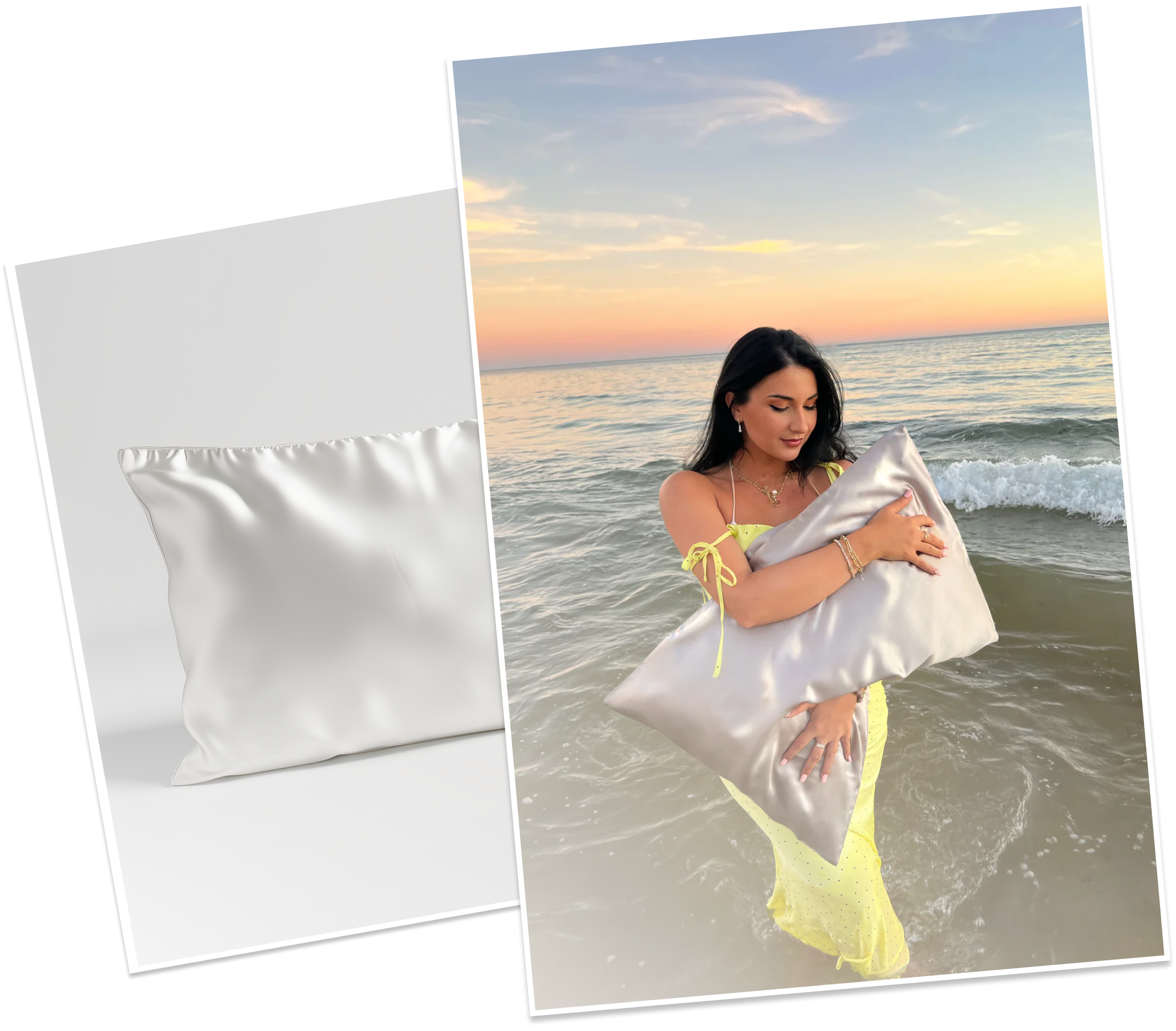
Is It Good to Wrap Hair at Night?
Share
Keeping hair healthy overnight is often overlooked, yet it plays a vital role in preventing breakage, frizz, and dryness.
Many people ask whether there are benefits of hair wrapping at night that truly make a difference. The answer is yes, and very much so. Wrapping your hair before bed offers multiple protective benefits that help maintain shine, smoothness, and strength, regardless of your hair type.
Read on to explore why wrapping hair at night matters, the best techniques for different hair types, and the materials in hair turbans and wraps that deliver maximum protection.

Reversible Silk Hair Wrap - Pink
Why Wrapping Hair at Night is Beneficial
When we sleep, hair rubs against pillowcases, creating friction. This friction leads to split ends, breakage, and tangled strands. Wrapping hair acts as a barrier that keeps strands aligned and reduces damage.
Here's how:
- Minimizes friction: A wrap prevents the rough contact between hair and cotton pillowcases.
- Retains moisture: Hair oils and hydration stay locked in instead of being absorbed by fabric.
- Controls frizz: A smooth wrap ensures hair cuticles remain flat, reducing morning frizz. This is one of the top reasons to wrap hair at night, especially for dry hair.
- Preserves hairstyles: Whether curls, straightening, or blowouts, wrapping keeps styles intact overnight.
- Encourages growth retention: Less breakage means hair maintains its length and health.
Best Fabrics for Hair Wrapping at Night
Not all materials are equal when it comes to protecting hair. The right fabric determines whether wrapping will help or harm your strands.
Silk Wraps
Silk is the most recommended option for nighttime hair wrapping. Its smooth surface reduces friction and helps hair retain natural oils. It's also lightweight, breathable, and prevents overheating. However, ensure that it's a pure organic mulberry silk hair wrap, like the ones offered by HoneyLux.
Satin Wraps
Satin offers some of the benefits close to silk but never exactly the same, as it's a synthetic fabric that's not breathable. It glides over hair, protecting curls and straight styles to some extent, while preventing unnecessary tangles.
Cotton Wraps
Cotton should be avoided for wrapping. While natural, cotton is a fabric that absorbs oils and moisture from hair, leaving strands dry and brittle.
How to Wrap Hair Based on Hair Type
Every hair texture has unique needs. The wrapping technique varies depending on whether you have curly, straight, or chemically treated hair.
Curly and Coily Hair
- Apply a lightweight leave-in conditioner or hair oil before wrapping.
- Use a silk or satin scarf and tuck ends neatly to avoid dryness.
- The pineapple method (high loose ponytail) can be combined with wrapping to protect curls.
Straight Hair
- Brush hair to remove tangles.
- Part into sections and smooth strands in one direction around the head.
- Secure with a silk scarf to keep hair flat and frizz-free.
Chemically Treated Hair
- Always apply a moisturizing product to counter dryness from treatments.
- Wrapping helps extend the life of relaxers, keratin treatments, and blowouts.
Step-by-Step Guide to Wrapping Hair at Night
- Detangle thoroughly using a wide-toothed comb.
- Moisturize lightly with oil or leave-in spray.
- Divide into sections if hair is thick or long.
- Wrap around the head in a circular motion, smoothing strands as you go.
- Secure with a silk or satin scarf or use a wrap cap.
- Tuck in loose ends to prevent frizz.
Great Additions to Go Alongside Hair Wrapping
For those who prefer not to wrap, there are other protective methods to consider.
- Silk Pillowcases: Pure silk pillowcases reduce friction even without a wrap.
- Bonnet or Sleep Cap: Easier to wear, especially for short or natural hair.
- Braiding Before Bed: Loose braids reduce tangling and create natural waves.
- Protective Hairstyles: Twists, buns, or rollers can preserve styling overnight.
Common Mistakes When Wrapping Hair
Even with the right wrap, mistakes can limit results.
- Using cotton scarves: These cause dryness and breakage.
- Wrapping too tightly: This puts stress on roots and may cause traction alopecia.
- Skipping moisture before wrapping: Dry hair wrapped overnight will still break.
- Neglecting regular wash care: Wrapping helps, but clean and conditioned hair is essential.
Does Wrapping Hair Help with Growth?
Wrapping does not directly make hair grow faster, but it helps with reducing breakage and split ends, allowing you to retain length over time. Consistent protection ensures hair remains strong, which supports healthier growth.

Reversible Silk Hair Wrap - Royal Blue
Who Should Wrap Their Hair at Night?
While wrapping is beneficial for nearly everyone, it's especially useful for:
- People with curly or coily hair who want to preserve definition.
- Those with chemically treated or colour-treated hair.
- Individuals who frequently heat-style their hair.
- Anyone looking to minimize frizz and maintain smoothness overnight.
Tips for Maintaining Wrapped Hair Overnight
- Choose breathable hair wraps to avoid scalp sweating.
- Wash silk wraps regularly to prevent buildup. Wash them gently by hand to keep them looking the same for years and offering benefits.
- Avoid heavy products before wrapping, as they may transfer to fabric. Even though silk doesn't absorb natural oils or any other products, it can get messy.
Final Thoughts
So, is it good to wrap hair at night? Absolutely. There are so many benefits of hair wrapping at night.
Wrapping hair protects strands, retains moisture, reduces frizz, and keeps hairstyles intact. Whether you have natural curls, straightened locks, or treated hair, incorporating wrapping into your nightly routine helps you wake up with healthier, shinier, and more manageable hair.
By investing in high-quality silk hair wraps, you not only safeguard your hair's strength and overall health but also extend the life of your hairstyles.

